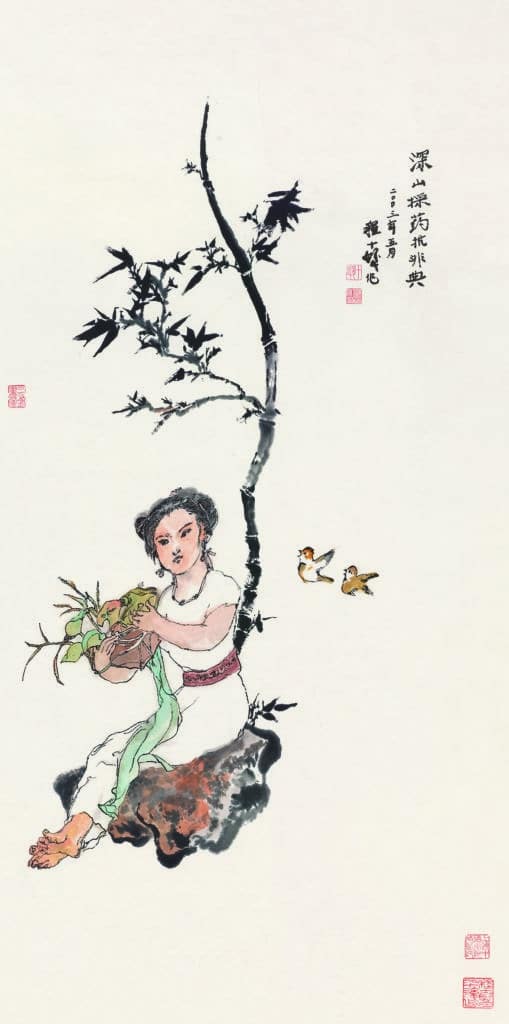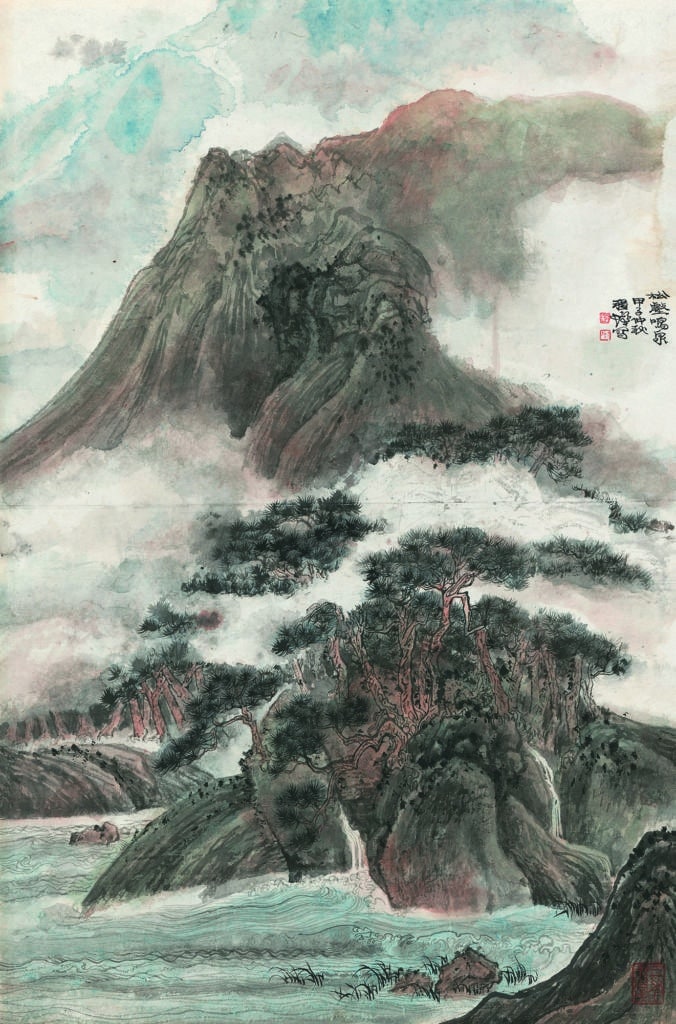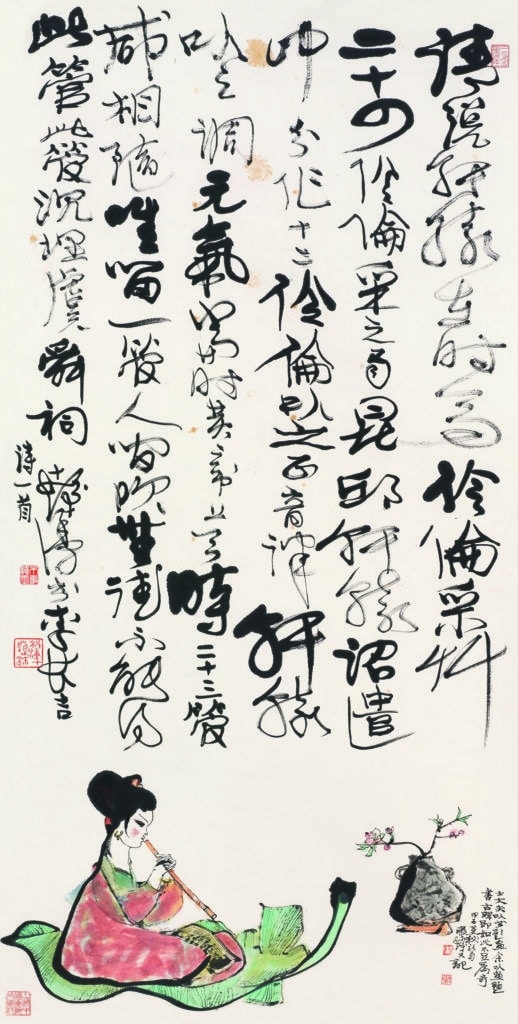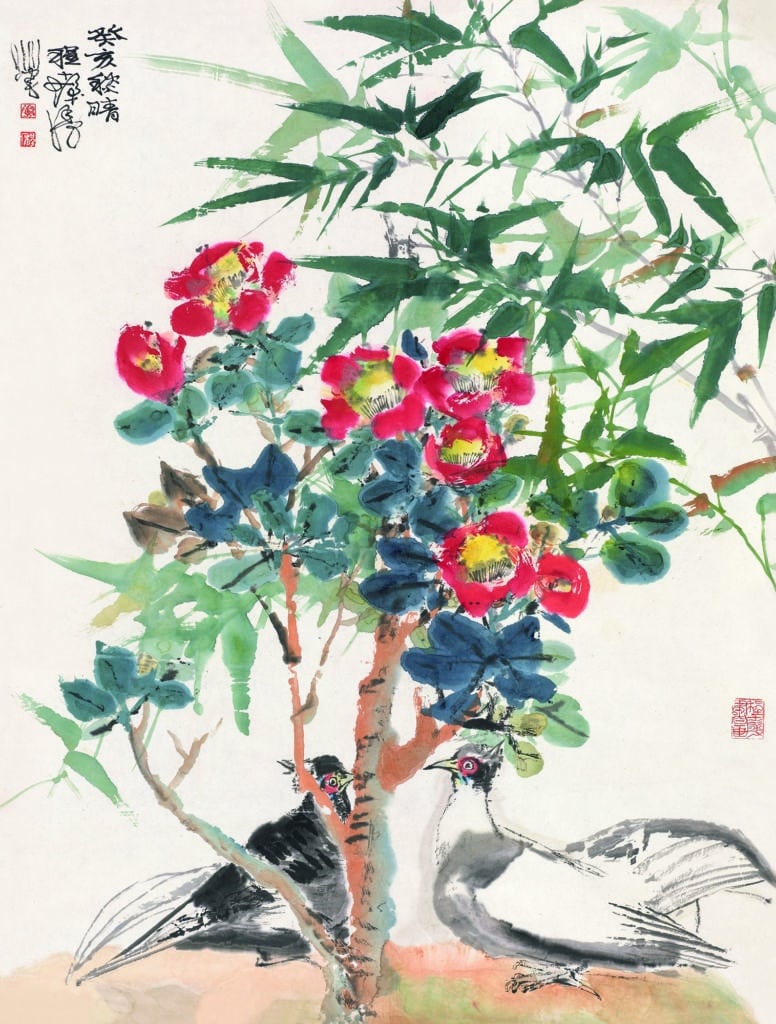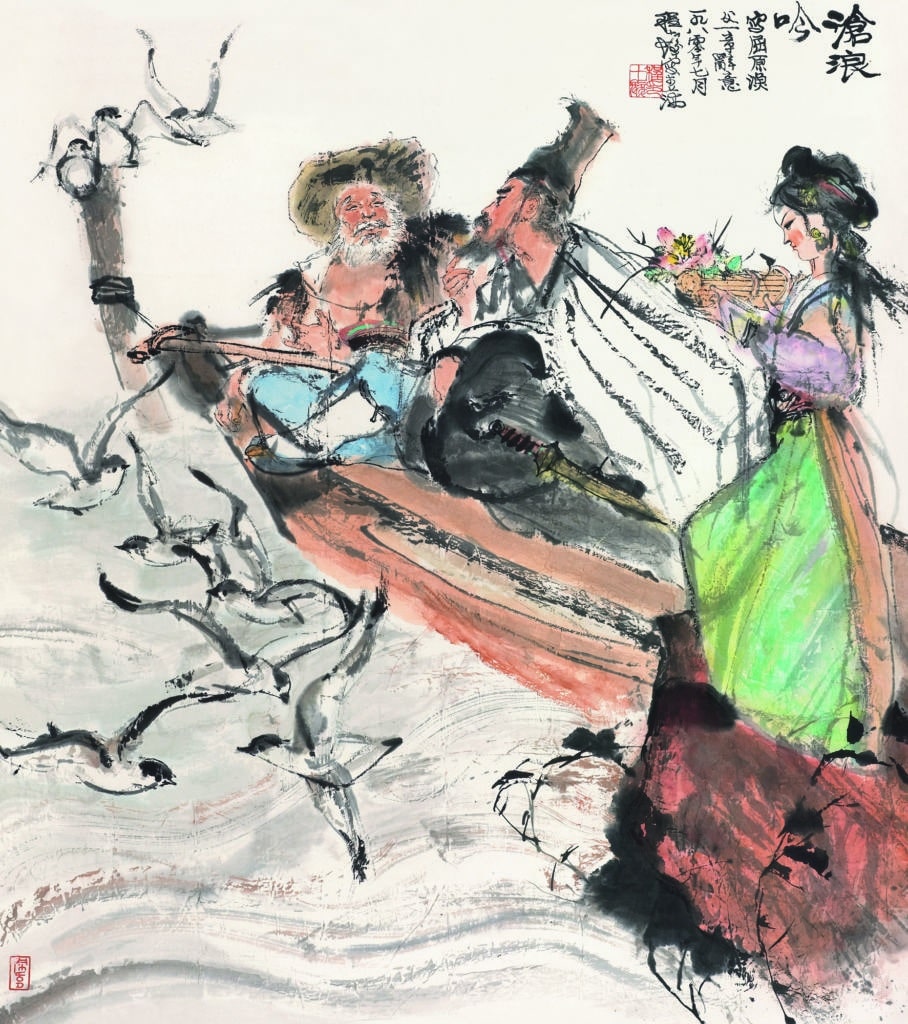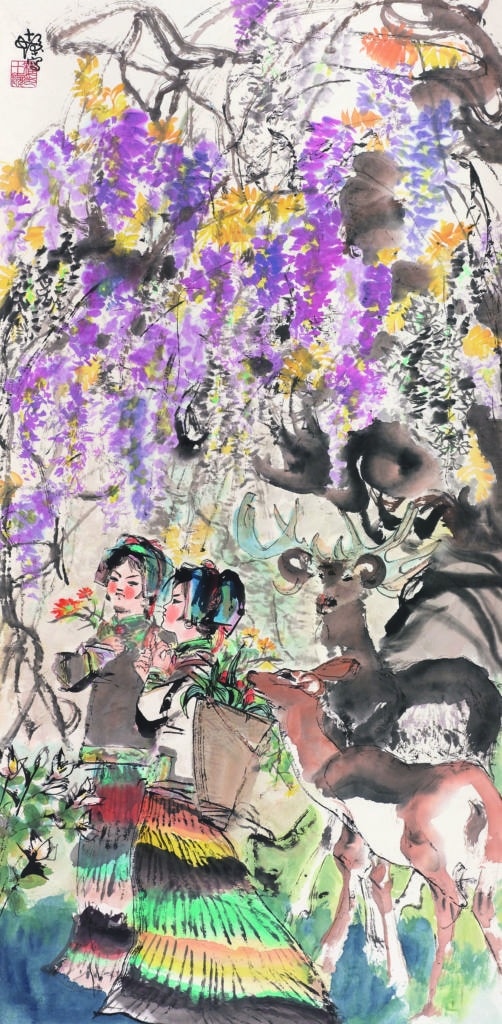Cheng Shifa Art Exhibition

Today, we are introducing the artist CHENG Shifa (1921-2007), a master of contemporary Chinese painting and a leading figure in Shanghai-style painting. He was known for combining Chinese techniques with Western painting methods. He formed a bridge between tradition and modernity.
The China Cultural Center in Brussels, the Shanghai Chinese Painting Academy’s Cheng Shifa Art Museum hope to bring some artistic delight by sharing these six paintings with a Belgian and European audience.
Cheng Shifa, Gathering Herbs in Mountains against SARS, 138×68 cm, 2003
During the SARS outbreak in China in 2003, Cheng Shifa, then 83 and Honorary President of Shanghai Chinese Painting Academy, insisted on painting with his colleagues to raise money for SARS research and treatment, regardless of his age and weakness. Due to his own illness, he could not stand up for long. He could only paint remaining seated and move the paper when maneuvering the brush, instead of standing next to the desk and moving his own arm. After a week’s hard work, he managed to finish this painting with his heart and soul.
The girl in white dress in this painting is a symbol for doctors and nurses, often lauded as “angels in white” in Chinese. The girl is sitting on a rock in front of an elegant bamboo plant, the painting of which is known to be Cheng’s forte. The girl is holding a bamboo basket firmly, full of herbs she gathered, as if those are the powerful weapon against the SARS monster.
Cheng created this painting with great love. Even at this age with his physical weakness, he still managed to portray everything precisely and vividly, with soft and clear colors. The two fledgling birds flying next to the girl are especially lively and fun, as if they are to come to life. From them, we see the painter’s sincere love of life.
Cheng Shifa, Spring Murmuring through Pinewoods, 75×50 cm, 1984
Apart from abandoning themselves to nature, ancient literati often had landscape paintings at home in pursuit of a state of “mind travel”. Traditional landscape painters are inspired by nature and advocate the human-nature integration, an idea suiting the literati’s taste.
This is one of Cheng Shifa’s more traditional landscape paintings among his many works. In this painting, spring water flows down the mountain through pinewoods and rocks in the mist, all reflected by the artist’s unrestricted use of ink and colors. In his early years of studying, Cheng began to limn mountains and rivers through tracing traditional realistic works, which later shaped his unique preference for thick strokes and large color blocks to draw in a wild manner. In this work, the realism was inspired by painter Shitao’s insights of nature, and the crisp and layered effect came from a mix of WANG Meng’s raveled-rope shading and Juran’s long hemp-fiber shading. As a result, through layers upon layers of clouds and woods, the mountain rocks are found, covered by mosses like quick raindrops. This is definitely a masterpiece of Cheng Shifa’s landscape paintings.
Cheng Shifa, Inspired by a Poem of Li He, 137.5×68.5 cm, 1984
The painting featuring Cheng’s calligraphy as main part is inspired by a poem by LI He, a prominent poet of the Tang Dynasty. The poem, entitled Bitter Bamboos: A Tiaoxiao Ballad, tells a mythical story: “When Xuanyuan, also known as the Yellow Emperor, was on the throne, he ordered his court music official Ling Lun to gather 24 bamboo plants from the Kunlun Mountains. Ling Lun obediently made 12 of them into pitch pipes and created the 12 notes of the chromatic scale of ancient Chinese music, while Xuanyuan used the other half to restore vitality. Eventually, Xuanyuan took 23 of the pipes back to Heaven and left only one to men with great virtue. Unfortunately, no one was truly qualified and the flute was henceforth buried deep under the Temple of Yu Shun.”
Cheng often quoted stories of historical personages or poems in his drawings to express certain emotions. At the bottom of the painting sits a young girl on a musa basjoo leaf, who is playing the 12 tones created by Ling Lun with her bamboo flute, the origin of Chinese ritual music. Cheng’s bold use of thick contour lines that are commonly seen on carved stone statues and the flexible and varied change of thin, thick, curved, and angular strokes, as well as the rhythm he developed in the brilliant contrast between similarity and dissimilarity and heavy and light ink, all contribute to a balance between variation and norm. The painting, therefore, generates an extraordinary sense of beauty out of the smoothing synthesis of harmony and contrast.
The other two-thirds of the painting is filled up by Cheng’s vigorous and unconstrained calligraphy of Li He’s poem. Versed in penmanship, Cheng has developed a unique style of handwriting through his audacious and innovative use of ink and strokes. As an old Chinese saying goes, “Calligraphy and painting grow from the same soil.” Cheng has achieved a complementary combination of these two art forms in his artwork.
Cheng Shifa, Camellia and the Pheasants, 91.5×69.5 cm, 1983
The painting depicts two pheasants under a blooming camellia which is set at the center of the painting. Cheng used the technique of “mogu” (boneless painting) on the camellia and created a light source for it. Along with the smooth and elegant brushstrokes, the color scheme Cheng chose, which includes a transition from dark to light, cold to warm, makes the camellia flowers look vivid and gorgeous. Painted in a seemingly careless freehand style, the pheasants, one black and one white, are drawn with few simple strokes and shading but look lively and alert.
At the top of the painting are a few slanting bamboo branches, also in freehand style. Saturated with water and mingling with each other, the bamboo branches add a fresh and pleasant atmosphere to the painting. Cheng gave a lot of thought to choosing the colors, combining the bright and quiet colors, so the painting looks both vibrant and fresh with an elegant charm.
Cheng once said that there are two key elements in a bird-and-flower painting, the “vividness” and the “lifelikeness”. To create a sense of “vividness”, the painter needs to “be emotionally connected with the objects, revealing their inner essence”. The so-called “lifelikeness”, as the word itself indicates, requires “the external appearance of the object”. The Camellia and the Pheasants is a perfect example of Cheng’s achievements in combining both “vividness” and “lifelikeness” which was always his artistic pursuit. The camellia and the pheasants are depicted so vividly that the audience may feel that they were about to come to life.
Cheng Shifa, Song of Surging Waves, 109.5×97.5 cm, 1980
This painting depicts a scene in which QU Yuan (c. 340-278 BC), a Chinese poet and politician who lived during the Warring States period, and a fisherman sit and chat on a fishing boat among surging waves. The diagonal composition presents rough waters and flying gulls on one side and the fisherman, Qu Yuan and his maidservant CHAN Juan on the other. With hair and beard completely grey and dressed in a straw cape and hat, the fisherman is talking to Qu Yuan, wearing a worldly-wise smile. Qu Yuan, gaunt and emaciated, dons a high hat, a long sash and a white cloak, obviously worrying about something but his eyes filled with persistence. The beautiful young maid Chan Juan holds a basket of flowers, standing on the shoreside and waiting to serve.
The whole painting creates an amazingly open, calm and solid atmosphere, in which all these characters were thoughtfully revealed in an unstable diagonal composition. Cheng Shifa adopted the techniques of ink wash paintings to portray the gulls and the vast expanse of misty water, which stretches far into the distance and joins the sky at the horizon, rendering the scene as an integral whole and an open vision.
The choppy water and gulls flying up and down not only add vigor and vitality to the painting but also provide a contrast to the hazy mist. The fishing boat and people, mainly colored in ocher, are presented firmly, like rocks that stand obliquely among a torrential river, adding a tone of solidness into the roaring waves. By contouring the figures’ faces with exquisite lines, outlining their body shapes with simple brushstrokes, while applying shading to them, Cheng delivered an integral image and overall sense of movement instead of a striking verisimilitude.
Cheng Shifa, Ever-Blooming Wisteria, 139×68 cm
As a versatile and prolific artistically accomplished painter, Cheng Shifa formed his unique painting style in his early years. Featuring free yet exquisite use of brush and ink, his paintings are expressively romantic with a lively atmosphere. In his Ever-Blooming Wisteria, these characteristics are fully reflected, where each and every element is pleasant, like the wisteria’s cascading vines and blossoms and the beauties underneath. If not properly dealt with, the combination of flowers and beautiful girls can easily become kitsch. However, through Cheng Shifa’s robust and vivid strokes, it becomes a classically romantic piece of work with his distinctive style.

